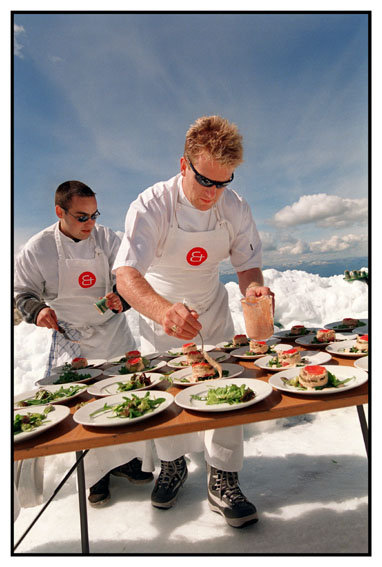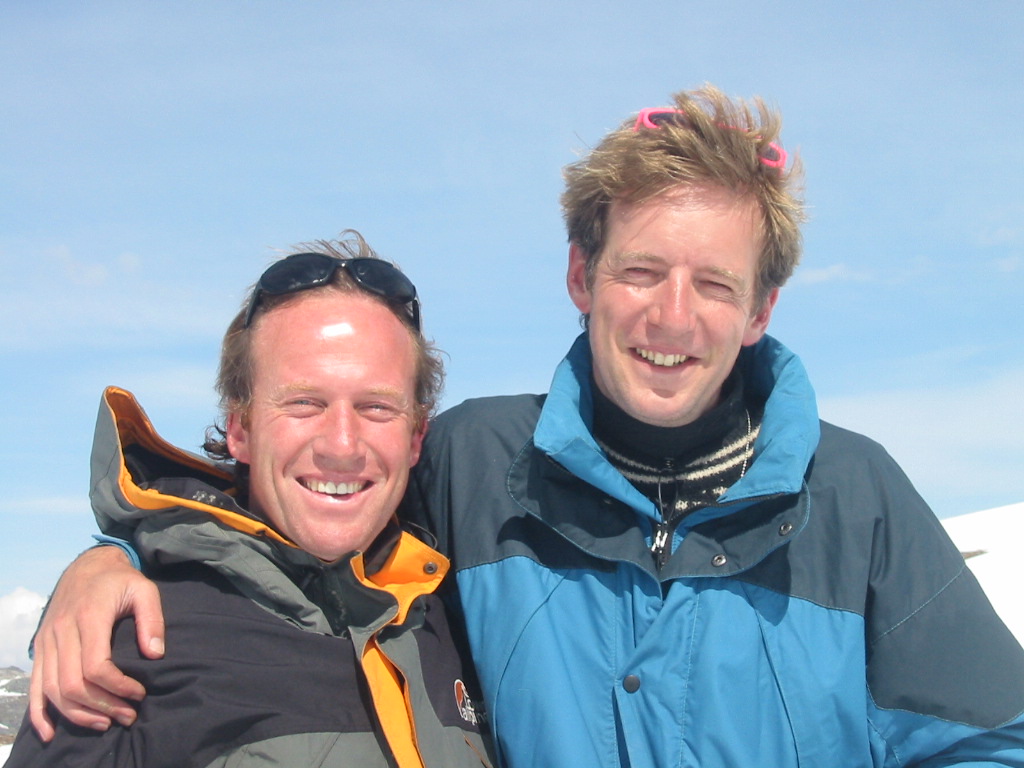
Why should twelve journalists and a couple of photographers come to be sitting on the top of a Norwegian glacier one sunny day in June, eating tian of crab with capelin roe, demi-smoked salmon with tzatziki, beurre blanc and pomme puree followed by raspberry crème brulee?
Because we were the privileged guests of Paul & K, also known as Paul Rhodes and Kjartan Kjetland, gourmet chefs boasting Michelin stars and stints at some of the world’s fanciest diners - Chez Nico in Park Lane, Raffles Hotel in Singapore… And why had they invited us? Because they want the world to wake up to extreme dining, where individuals or groups can hire them to cook up a storm in the middle of nowhere, or indeed the middle of somewhere.
It was a scene from a French surrealist movie: the two of them dressed in their full chefs’ getup, tall hats and all. They had constructed a dining area in the snow, complete with a white table-clothed central table. Below us lay a giant fjord, glinting in the sunlight. We were all kitted out in ski gear, having spent the previous couple of hours zipping down the Folgefonn glacier and being towed back up by a caterpillar snow truck, and now we were getting gently sizzled in the dazzling light of a Norwegian afternoon. We couldn’t believe our luck!
It did seem quite a long way to come for a bit of grub, but that’s the idea. Paul & K offer to russle up their five star menus on a Serengeti hilltop, a hot air balloon or a Caribbean beach. Just say the word and the foie gras will be put on ice and the venison steaks will slip into the travel bag.
Even for those who have visited Norway, this was pretty far off the beaten track. We flew into Haugesund, a pretty fishing town on the west coast, with colourful wooden houses and a scattering of cosy, attractive bars and restaurants. Among them is Paul & K’s Sixth Floor, a restaurant in the centre of town with a high, wooden-beamed ceiling and an air of class, to accompany the culinary delights. It’s a converted sea loft with great views over the harbour.
Returning from the glacier, we were served soup of Jerusalem artichoke with fried mushrooms and truffle oil, grilled scallops with a fennel puree with saffron and a soy beurre noisette, crispy pollock with tagliatelle of courgettes and a grapefruit mustard sauce, breast of roast duck salsafis, French beans and Arabica sauce, finishing up with almond crumble with mascarpone and strawberries, ginger ice cream and fried strawberry with balsamic vinegar syrup. Quite a mouthful.
One of the bonuses of the experience is being able to quiz the chefs on their recipes and get some inside information on how they work. Who exactly thought of putting grapefruit mustard on a fish dish? What kind of strawberries are best for frying? It was a bewitching cascade of flavours and textures. Yet both Paul & K have a refreshingly straightforward attitude to fine dining. There’s no great mystery, you just chose fresh, flavoursome ingredients and pay an extraordinary amount of attention to detail: “Every carrot, every baby onion has to be exactly the right colour,” says Paul of his time as executive head chef of the Nico chain, where he won his Michelin stars.
All the more tricky on the top of a mountain, of course. It was a marvelous experience, being waited on as we sat on rugs on the snow. It made us giggle, the outlandishness of it, the hedonism and beauty, the superabundance of rich, exquisite foods, the heady thrill of being so high up in the world, gazing at an ice-carved landscape where the summer sun never sets.

On the way back we visited a viking camp and sat in a large barn shaped like an up-turned longboat – which is how these barns were originally built – snuggled up on animal hides, looking at the central fire, the only form of light and heat in the building. It was quite dreamy. You did get a feeling of time travel, with all modern materials and conveniences melting away as the shadows played on the dark wooden walls.
We were served a Viking meal: shank of wild lamb, root vegetables, mashed potatoes and rosemary jus. The meal came on a flat block of wood, which meant the jus tended to dribble on to the table, but then Vikings aren’t renowned for their fastidious table manners. For dessert came a heap of fresh berries on a ‘pain perdu brioche’ and vanilla ice cream. This too leaked onto the table.
A final visit was to the town of Skudesneshavn, another coastal town with narrow cobbled streets and cute wooden houses. Once again we swam in the sea, me and a another journalist who stripped to her bra and knickers before diving into the choppy harbour waters. We pushed across to the opposite harbour wall like seals.
The food was consistently fantastic: on the first night we had a traditional lamb stew called Farikål, served in cabbage with black peppercorns and boiled potatoes, which was a treat. The fish we had, including poached cod and pollock, was moist and aromatic.
Then for dessert we had Queen Maud pudding, unique to Haugesund, which is a bavaroise confection of cream and egg mix laid in layers with grated chocolate in between. In the land of Ibsen, there is nevertheless a taste for luxurious food. (Queen Maud, by the way, was English: she was Queen Victoria’s granddaughter and married her first cousin Prince Charles of Denmark, who became King Hakkon II of Norway in 1905 when the country became independent. She was a weak and sickly woman, so maybe this cake cheered her up).
Altogether, this was a very special and memorable trip which I’d recommend to anyone looking for a quirky long weekend in a place which your friends will never have heard of, which is untouched by mass tourism, which gives you clean air, striking views, pleasant, welcoming people, and – if you manage to get hold of Paul & K – some of the best gourmet dining you’ll ever experience.